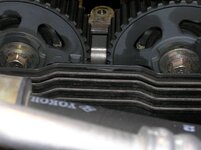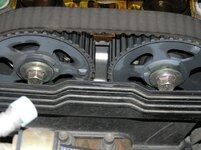I recently purchased a 2002 Mazda Protege5, 68,000 miles, automatic transmission, 2.0 litre. This isn't our first venture into Mazdaland, having had 3 Mazdas before this, an '86 323, a 2000 Protege sedan and a 2007 Mazda3. I wasn't thrilled about the 3 due to the sedan construction and visibilty from the driver's position. And I could not put my golf clubs in it easily. ;-) However, I have never driven a car with a better suspension and the 2.0/auto ran strongly and gave reasonable fuel economy.
The Protege5 is a style I have always liked but is very rarely available in our area (central North Dakota). When we found this one, we decided to reshuffle our fleet.
However, 2 items of concern soon became apparent. One, the fuel economy is abysmal compared to the 3, around 20 mpg or less around town. Two, there is a knocking note to engine area. I use and have used for some time a Scangauge to monitor the engine so the fuel economy issue became apparent quickly.
Looking over the posts, there appeared to be some concern with the EGR. I pulled the EGR and attempted to clean it. This effort appeared to be futile and the EGR valve will likely need a replacement soon. The engine runs a bit smoother but there was no effect on the fuel economy or engine noise. There was no CEL prior to working on the EGR valve.
Any suggestions to items to look at relative to fuel economy other than basic maintenance items will be appreciated.
The engine noise may be a rod but for now, let's assume it is not. The noise is very similar to the popping of a single throat carburetor without an air cleaner and is proportional to the engine speed. Is there anything in the intake that would create this sound or something related to the emissions control system. This does not sound like an exhaust leak, either.
Any responses welcome and this should get the discussion started.
Thanks!
Les
The Protege5 is a style I have always liked but is very rarely available in our area (central North Dakota). When we found this one, we decided to reshuffle our fleet.
However, 2 items of concern soon became apparent. One, the fuel economy is abysmal compared to the 3, around 20 mpg or less around town. Two, there is a knocking note to engine area. I use and have used for some time a Scangauge to monitor the engine so the fuel economy issue became apparent quickly.
Looking over the posts, there appeared to be some concern with the EGR. I pulled the EGR and attempted to clean it. This effort appeared to be futile and the EGR valve will likely need a replacement soon. The engine runs a bit smoother but there was no effect on the fuel economy or engine noise. There was no CEL prior to working on the EGR valve.
Any suggestions to items to look at relative to fuel economy other than basic maintenance items will be appreciated.
The engine noise may be a rod but for now, let's assume it is not. The noise is very similar to the popping of a single throat carburetor without an air cleaner and is proportional to the engine speed. Is there anything in the intake that would create this sound or something related to the emissions control system. This does not sound like an exhaust leak, either.
Any responses welcome and this should get the discussion started.
Thanks!
Les


